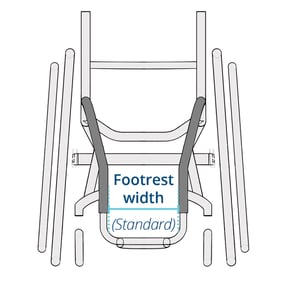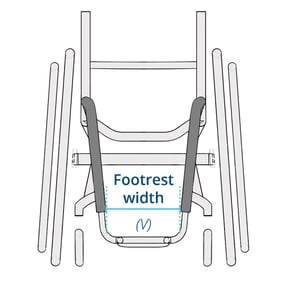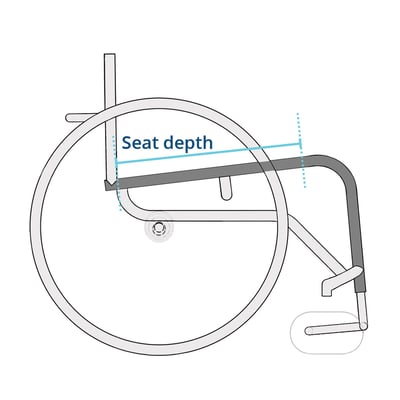This is the 9th blog in our manual wheelchair guide series. See the 1st blog, 2nd blog, 3rd blog, 4th blog, 5th blog, 6th blog, 7th blog, and 8th blog. Check out the Manual Wheelchair Guide to learn more.
We continue looking at configuring a K0005 wheelchair to an individual. So far we've discussed seat-to-floor height, seat slope, ergo seat, foot support-to-seat-length, front frame angle, seat width, and front seat width. Today we're looking at footrest width and seat sling depth.
Footrest Width
This measurement allows you to match the footplate with the LE positioning that is comfortable and appropriate for the client. Someone who has large legs or LE edema may not need any front seat taper. Someone whose lower legs are smaller than their hip width may need some leg rest taper.
Footrest width measurement
Below are some guidelines on how to measure for footrest width. It's important to remember that footrest width varies by person and preference. Select a width that allows for adequate space for the client’s feet and tapers to the client’s desired position. Measure across both the client's feet with shoes.
 |
 |
|
Standard Taper - Measure from inside to inside of the front frame tubes. The inside to inside measurement is used here because this is the space required for the w/c user’s feet and LEs. |
V - Measure from the inside of front frame tube to inside of opposite front frame tube 2 ½” above footrest |
Footrest width - too tight
- The tubes press on the client's legs or feet
- The footplate may not be wide enough to allow the feet to pivot for transfers if the client leaves their feet on the footplate for transfers
Footrest width - too loose
- The client does not have adequate foot/LE positioning coming from the WC. Their legs and feet may lose position, especially with spasticity or going over bumps
- This can decrease environmental access by increasing the WC footprint
Seat Sling Depth
The goal of seat sling depth is to maximize support and pressure distribution without interfering with LE positioning. An appropriate depth will also help provide optimal stability in the wheelchair.
Seat depth measurement
WC measurement is from the back posts to the leading edge of the seat upholstery.

Reminder: it’s best practice to take the client’s wheelchair measurements with them seated in a demo or their current wheelchair. This is especially true for Seat Sling Depth, because this measurement is relative to how the person needs and wants to sit in their wheelchair. Anatomical measurement is from behind the user's hip including residual tissue to their popliteal fossa AND should account for where they want to position their legs, more or less tucked.
Seat depth - too short
Decreases femoral contact for pressure distribution which can lead to pressure injury and decreased stability in sitting.
Seat depth - too long
This may result in sliding forward to decrease pressure behind the knees, resulting in poor posture and decreased propulsion efficiency.
May result in the leading edge of the seat upholstery and/or cushion digging into the user’s popliteal fossa and/or calves increasing risk for pressure injury.
 Stacey Mullis, OTR/ATP
Stacey Mullis, OTR/ATP
Director of Clinical Marketing
Stacey serves as Director of Clinical Marketing for Permobil. A practicing OTR for over 20 years, she has experience in school-based pediatrics, inpatient rehabilitation, long term care, and home health. With her interest in wheelchair seating and positioning, Stacey engaged the challenges of providing appropriate seating in various clinical settings. She now uses this experience to develop programs and resources to educate clinicians on the principles of seating and wheeled mobility. She is passionate about equipping clinicians and through her previous role as Director of Clinical Education with Comfort Company and now with Permobil she has taught nationally and internationally to increase therapist capacity in this specialty area. Mullis graduated from Western University in London, Ontario, Canada with a BA Linguistics and BSc Occupational Therapy. She is a member of the NCOTA, CTF Executive Board, NRRTs, RESNA, and AOTA.
 Ginger Walls, PT, MS, NCS, ATP/SMS
Ginger Walls, PT, MS, NCS, ATP/SMS
Director of Clinical Sales and Education
Ginger has 25 years of experience as a physical therapist in the area of neuro rehab and wheelchair seating/mobility. She directed the Outpatient therapy clinics and the Seating/Mobility Program at Medstar National Rehabilitation Hospital in Washington, D.C. Additionally, Ginger has provided a variety of continuing education courses and lectures in the area of seating/mobility for many years. She has presented at major industry conferences including ISS, RESNA, and the PVA Summit. Ginger took on the role of Clinical Education Specialist for Permobil in 2015 and was appointed Director of Clinical Sales and Education in 2020.
